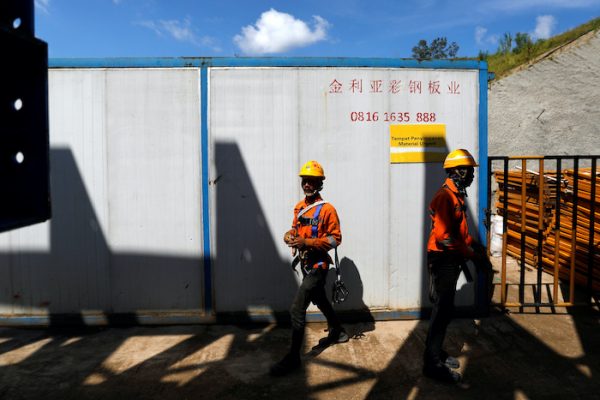The usual narrative is that China, under the assertive leadership of President Xi Jinping, is using the BRI as part of a coherent strategy to advance its national interests. Many believe that China practises ‘debt-trap diplomacy’ — providing loans to recipients that are incapable of repaying them to increase its influence over recipient governments and even seize strategic assets upon default.
In our report, Lee Jones and I argue that China’s BRI is not a carefully designed plan, and that debt-trap diplomacy is a myth. There are three serious misconceptions about the BRI. The first misconception is that the BRI is motivated by geopolitical objectives. Despite some posturing, the BRI is an attempt to address China’s own economic challenges.
China’s long-term growth model — debt-fuelled infrastructure investment and surpluses from export-oriented industrialisation allowing the cycle to repeat — is failing. Subnational governments’ duplication of industry and infrastructure, massive infrastructure spending after the global financial crisis, and declining demand for Chinese exports have created significant overcapacity and indebtedness. The BRI is intended to stimulate external demand for Chinese goods, services and capital. Approved projects do not necessarily correspond to the six ‘corridors’ outlined in BRI policy documents, and Chinese investments in developed non-BRI countries are growing faster than in BRI countries.
The second misconception is that China’s development financing system executes top leaders’ commands seamlessly. This perception is understandable given China’s opaque and authoritarian political system and governance structures. In reality, China’s development financing institutions are fragmented and poorly coordinated, inhibiting the pursuit of detailed strategic objectives. Top leaders and central agencies attempt to shape the BRI’s overall direction through often vague policy statements and broad commitments to particular countries or regions.
Detailed implementation is left to other agencies that often operate with considerable latitude. The most important of these are the hundreds of state-owned enterprises (SOEs) that implement BRI projects. Although notionally under party-state control, central agencies struggle to regulate SOEs’ conduct abroad and they often flout Chinese regulations. They tend to pursue profits and attempt to harness the BRI to grow their market share or secure future revenue streams. They also compete ferociously for projects and engage in behaviours that have caused blowback for Chinese diplomacy. This loose system and SOEs’ global market inexperience have facilitated many poorly conceived overseas projects.
The third misconception is that China dictates the BRI to recipients. Much commentary on the BRI either ignores the recipients’ agency or treats them as dupes. But recipient countries play a critical role in shaping the BRI. Rather than unfolding from a Chinese blueprint, the BRI emerges piecemeal through diverse bilateral interactions between Chinese agencies and recipient countries.
Sri Lanka and Malaysia are often portrayed as victims of China’s debt-trap diplomacy. This thesis does not stack up. The most controversial projects in these states were initiated by the recipient governments in pursuit of their own domestic agendas. Their debt distress did not arise predominantly from the granting of predatory Chinese loans, but rather from the misconduct of local elites and Western-dominated financial markets. China has not benefited strategically from the upsets in these cases. It has faced negative reactions and pushback, though this rarely amounted to a total rejection of the BRI.
The common narrative about China’s BRI projects in Malaysia is that it was seeking influence over the strategically important Malacca Straits. The debt-trap narrative was further fuelled by claims that Beijing had inflated loans for the East Coast Rail Link (ECRL) and two gas pipeline projects in order to bail out the troubled sovereign wealth fund 1Malaysia Development Berhad (1MDB). When the Pakatan Harapan (PH) coalition surprisingly unseated the long-standing United Malay National Organisation (UMNO) led coalition, it suspended the projects, leading pundits to claim that PH was spearheading an anti-BRI pushback.
The ECRL and pipelines deal was actually proposed by former Malaysian prime minister Najib Razak and his crony Jho Low to cover up their misuse of billions of 1MDB funds for political and personal gain. Their criminal misconduct, which recently landed Najib Razak in jail, was facilitated by Western financiers including Goldman Sachs, not Beijing. The ECRL was not proposed by China but had been part of Malaysian development planning for almost a decade prior to its initiation in 2016.
The Malaysian government never fell into debt distress and there has been no prospect of any asset seizures. It is likely that Chinese authorities agreed to the deal because it seemed to be a low risk way of maintaining relations with a friendly government, given that Malaysia guaranteed the loan and that UMNO had ruled Malaysia since independence. PH’s shock win upended these assumptions. The new government did not cancel the ECRL, but instead negotiated the price down and secured more work for Malaysian construction firms.
Correcting the three misconceptions is critical for better policy engagement with the BRI, avoiding overreaction and improving developmental outcomes for finance recipients. It is possible that the BRI will have significant geopolitical implications, regardless of its current objectives and implementation. Avoiding undesirable developments requires understanding the BRI as it is today and responding accordingly.
Shahar Hameiri is Associate Professor of International Politics in the School of Political Science and International Studies, University of Queensland.
He is author of a recent report with Lee Jones, Debunking the Myth of ‘Debt-trap Diplomacy’, published at Chatham House.


This is a refreshing change from the anti BRI propaganda that dominates the Australian mainstream media. More than 150 countries have now signed BRI agreements with China, but not Australia that succumbs yet again to US influence. The current Australian plan to sign an agreement with India, Japan and the US is a pathetic attempt to create something in competition. Japan will almost certainly join the BRI and India has made separate arrangements with Russia, both being unwilling to be part of a US anti China project.